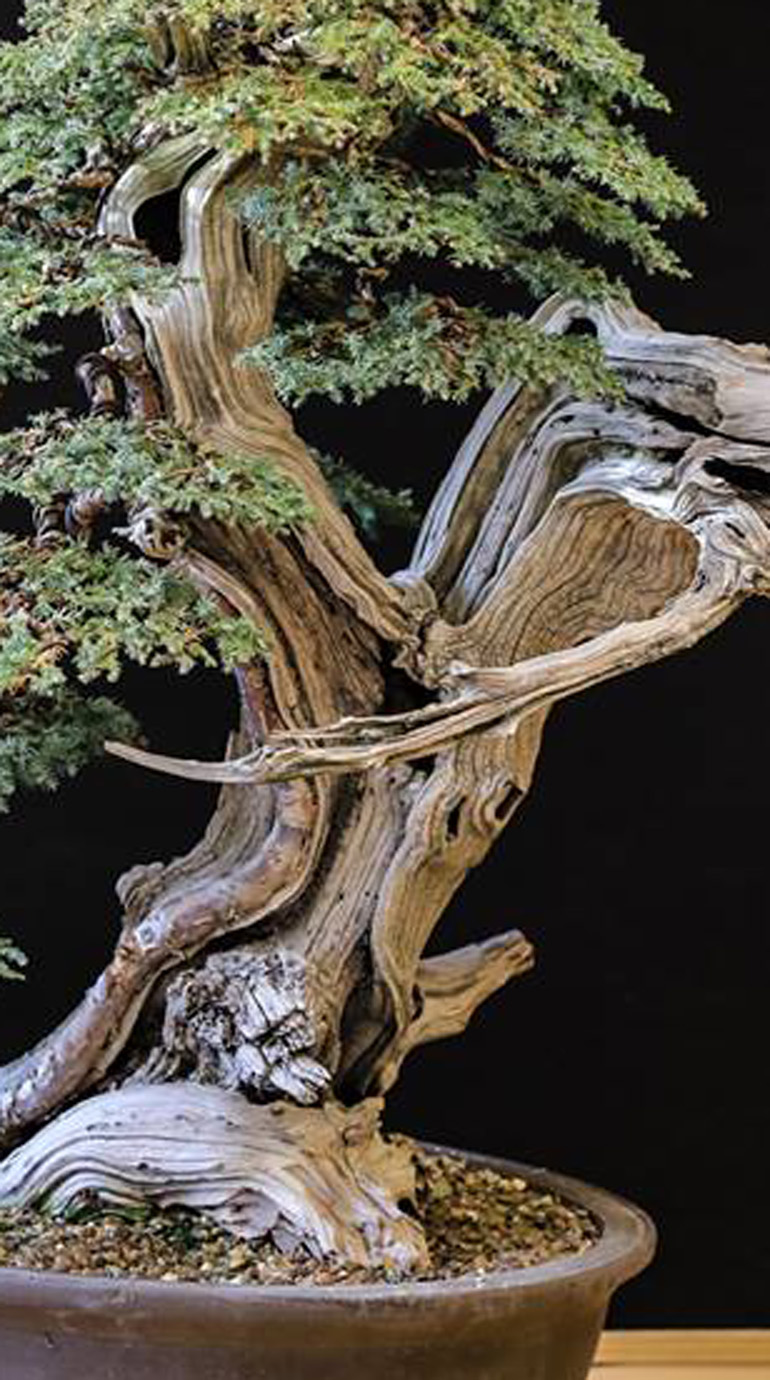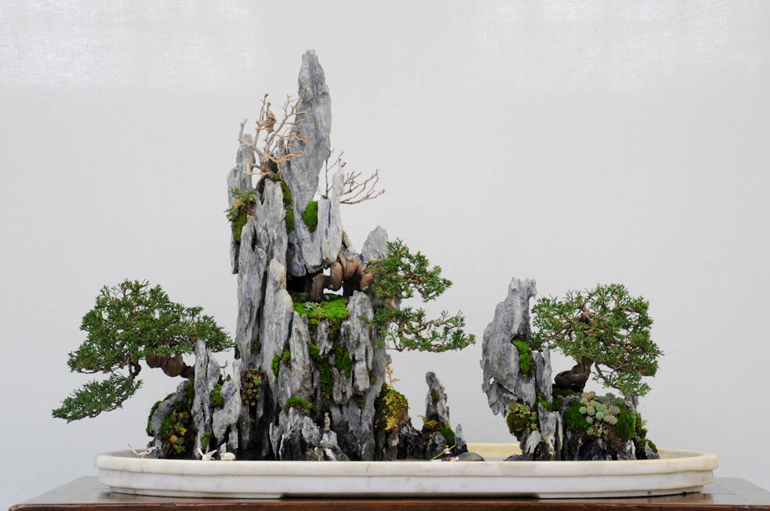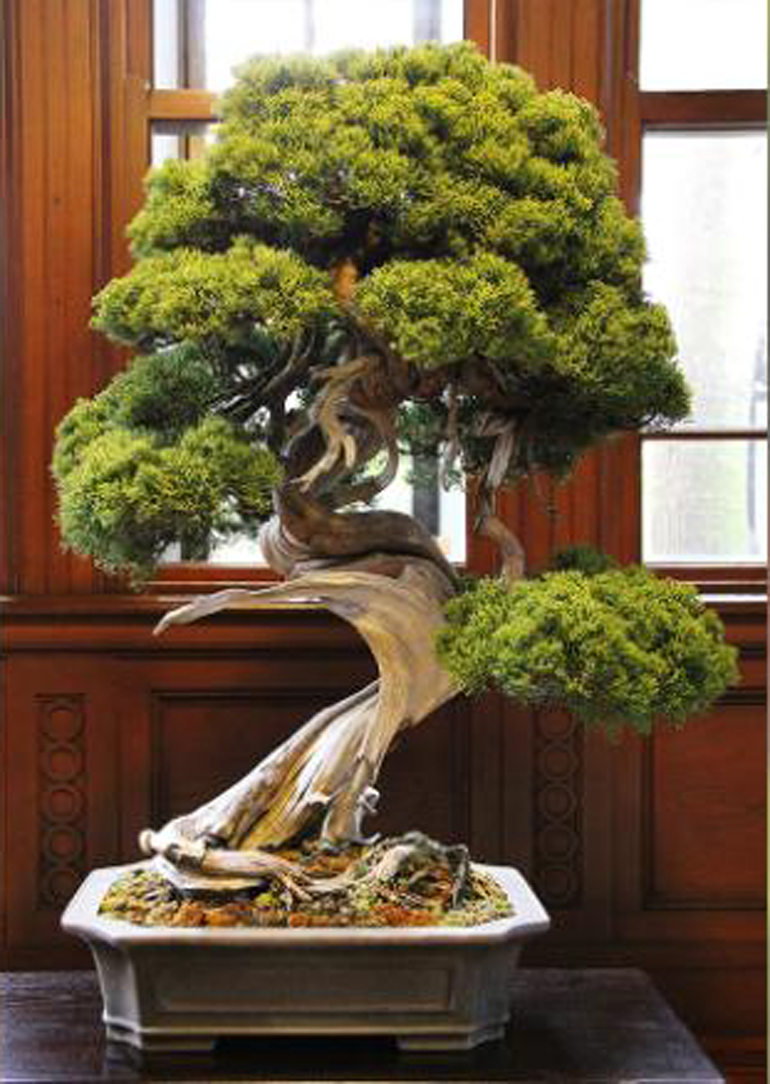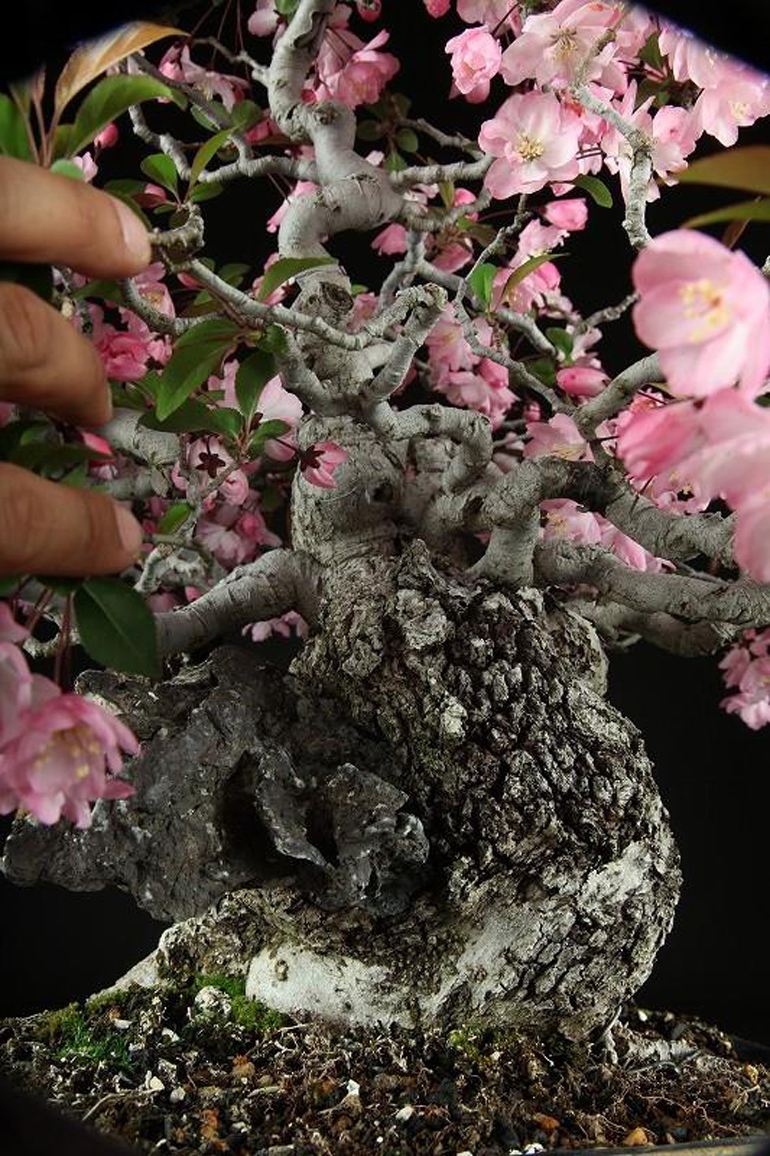Sheer Power & Beauty

I cropped this Ficus microcarpa for a close look at the sheer power and beauty of the trunk, pot and stand (the uncropped original is below).
It's by Huang,Ching-Chi of Taiwan
Variety unlisted. By Tung, Wen Chi
Malpigia glabra (Barbados cherry) by Hsieh, Cheng-Hua
Bonsai Are Leafing Somewhere (Just Not Here)

Japanese maple in the first flush of spring. This and the other trees shown here belong to Luis Vallejo. His caption for this selection reads... "Algunos arces, brotación" (some maples sprouting). The photos are by Miguel Krause
We featured some deciduous trees that belong to Luis Vallejo not too long ago. Now we’ve got more, but this time they are waking up and stretching . They’re all Japanese maples (Acer palmatum). If you’d like to know the varieties, you can visit Luis on facebook





Prize Wining Beech Bonsai

This magnificent Japanese beech (Fagus crenata) received the coveted Kokufu prize at the 88th Kokufu Bonsai Exhibition (the oldest and most prestigious bonsai exhibition in the world). Aside from its unique power and beauty, this tree provides a perfect example of what great ramification looks like (made even more obvious by the bright rusty-red leaf buds). The photo is from the World Bonsai Friendship Federation. Identification and other details were provided by Bill Valavanis.

Here's the original shot
Welcome to Our Brand New Website

This photo is from our first Bonsai Bark post. January 26th, 2009 So we're just past our tenth anniversary and it went by without any notice. Oh well...
What we won't let go by without notice is... We finally threw the switch and now you're on our brand New Website! (Bark is embedded in the new site). I hope you like it and as an added bonus we're offering 10% off on everything for orders 50.00 or more. (you need to put the sale code, LAUNCH in the box when you checkout)
Bonsai Before & After – Three Year Progression

A three year progression on a Himalayan juniper (Juniperus squamata) by Josef Burschi
We’ve got new Before & After for you. This time with an intermediate stage between the before and after. There is a small caveat however. The tree is a Tanuki* (Phoenix graft). I think most Japanese bonsai artists frown on Tanuki, or at least they don’t value them as much as other bonsai. But the tree looks good, so I don’t think it’s a big deal. You can see this tree and some other good ones on Josef Burschi’s fb timeling
After

Cropped for a better look at the trunk

Cropped even more. In addition to the deadwood, you get a good look at the living vein

More deadwood

The artist at work
*Tanuki (Phoenix graft) is when you attached a living plant to a piece of deadwood in an attempt to make it look as though it’s one plant. When it’s well done, it can be difficult to tell a Tanuki from other bonsai with deadwood
Bonsai Forest Rock Plantings
That's Ryan Neil's hand (Bonsai Mirai) posing for a professional photo with a very large root-on-rock planting. Here's his caption: "In the studio today with @hornbecker shooting for the Artisans Cup promotional material" (from 2015). He doesn't say what the tree's are. If you'd like to see the uncropped original, it's here
We’re on a bonsai forest binge these days, so let’s keep going. Though it’s questionable if you’d call these rock plantings forests, they do share the multiple tree and some of the landscape features you’ll find with more conventional bonsai forests
Three robust Shimpaku junipers on a rock. From the Omiya Bonsai Museum

Empire Bonsai's caption says "Buxifolio Bonsai forest, planted on a rock, by Luisa Alfaro." The Buxifolio part is a bit of a mystery. Buxifolia (with an a) is a species name, but without the genus, it could be any number of things. The leaves look tiny, so we'll try Neea buxifolia.

Juniper penjing
I borrowed this photo from a Bonsai Tonight post on Penjing. As usual, I'm impressed with the choice of material and the quality of photos on Bonsai Tonight and this one is no exception. For more detail, there are several very good closeups just a click away.
Thief Steals Over $100,000 Worth of Bonsai* Including a 400-year-old Shimpaku Juniper

This rare 400-year-old Shimpaku juniper was due to be entered in a Japanese competition this month
Theft of anything is always shocking and doubly so when the missing objects are irreplaceable, one of a kind living items. When and if they are ever found, missing bonsai might be badly damaged or even dead. And the chances of ever finding them are often slim
Here’s an except from our source WENY News (courtesy of Eugene Sekulow) …
“A bonsai thief has stolen seven… trees worth at least 13 million yen ($118,000)* from a garden space in Saitama prefecture near Tokyo.
“The loot included a rare 400-year-old shimpaku tree, a star of the bonsai world, which was due to be entered in a Japanese… competition this month…”
“The prize shimpaku alone was worth over 10 million yen ($90,000), according to Fuyumi Iimura, wife of the bonsai master who crafted the trees.”
Here’s a link to rest of the article and here’s a google link to several pages of articles on stolen bonsai.
*I’m always a little wary of precise value placed on bonsai (especially if insurance claims are about to be filed). No bonsai has a fixed value. At least until someone buys it. When that happens, you could say the purchase price is the tree’s value at that moment
Flowering Cherry Bonsai – Few and Far Between

This is perhaps the strongest Flowering cherry we've featured in our ten years of posting. Its muscular trunk, aged bark and profusion of lovely flowers make for an impressive showing
Good Flowering cherry bonsai seem to be few and far between. In our ten years of posting (about 3.500 posts), we’ve only featured three flowering cherries and I’m not sure about one (here’s one, here’s another and here’s the one I’m not sure about). We found this one on Michael Bonsai fb timeline, a steady source for quality bonsai photos
–

Close up of the trunk from the opposite side. That appears to be a piece of bark sticking out on the right. The white looks like a lichen of some sort

The other side. It sure does look like a piece of bark. It seems a little strange that is was left on the tree, but I suppose it tells a story. The fingers give a sense of scale

Cherry blossoms!
–
Mixed Forest Bonsai (& Others) by One of the Original Grand Masters

This magnificent mixed forest is by Saburo Kato, who was one of the original old masters of Japanese bonsai. You can find it and other remarkable trees in his timeless classic Forest, Rock Planting & Ezo Spruce Bonsai. You can also find some of the moist comprehensive how-to bonsai instructions anywhere
Continuing with our forest theme, today it’s four now famous forest plantings by one of Bonsai’s Grand Masters, Saburo Kato.
–
 This remarkable slab planting shows how much drama and power one strong tree can add to a forest. It's also a good example of what you can do with ground cover to enhance realism and beauty. Though the original, which appeared in Bonsai Today* issue 23, doesn’t say, it might be safe to guess that it's also by Saburo Kato. The trees look a lot like Ezo spruce (Picea glehnii), a specialty of Mr Kato's
This remarkable slab planting shows how much drama and power one strong tree can add to a forest. It's also a good example of what you can do with ground cover to enhance realism and beauty. Though the original, which appeared in Bonsai Today* issue 23, doesn’t say, it might be safe to guess that it's also by Saburo Kato. The trees look a lot like Ezo spruce (Picea glehnii), a specialty of Mr Kato's
Forest, Rock Planting and Ezo Spruce Bonsai
By Saburo Kato
–
This very large forest was on display at the 2017 World Bonsai Convention in Japan. Like so many other Ezo spruce forests, it was originally created by Saburo Kato. The photo was borrowed from Mark Fields, one of our lucky friends who made the trip to Japan.

Same forest, different perspective. Both this photo and the one above include people, which helps show just how immense this planting is. The photo was sent to us by Felix Laughlin, who is, in addition to being another lucky friend, is the President of the U.S. National Bonsai Foundation.

Close up. Realistically sized ground cover is an important piece in most great forest bonsai. This photo was also taken by Felix Laughlin.

The Remotest Hill, Mr Kato's most famous Ezo spruce forest from the cover of his internationally renowned book, Forest, Rock Planting & Ezo Spruce Bonsai. Here's Mr Kato's caption: "Ezo spruce (Picea glehnii). Sixty years ago I often traveled with my father to Ezo spruce in the large virgin forests on Kunashir Island off the cooast of Hokkaido. I selected the finest material to create this bonsai entitled The Remotest Hill."







